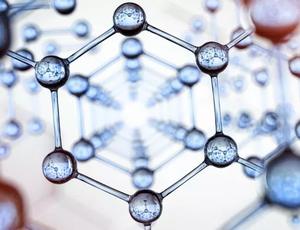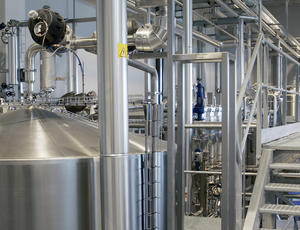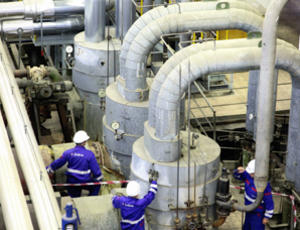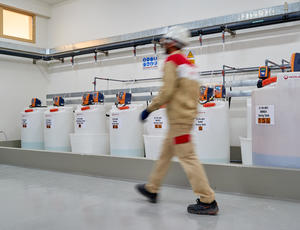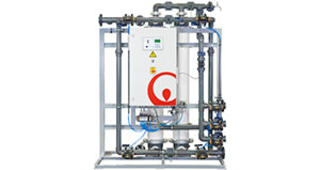Double pass reverse osmosis system for cosmetics applications
Overview
SENSA™ is a reverse osmosis (RO) system, which means that water gets purified through a membrane. Its double-pass RO configuration makes it so that the water purification process is done twice to result in a higher quality of water – removing over 99% of salts while achieving conductivity as low as 5 µS/cm and low bacteria (10 cfu/100 ml) .
The system has been designed for indoor conditions — temperatures from 5°C to 35°C, 90% maximum humidity, non-condensing, non-corrosive atmosphere, under cover installation, no direct sunlight — and offers high-availability with six models compliant with European standards.
How Sensa works
Inlet water passes through a semipermeable membrane with the help of a high pressure pump. Contaminants and other undesired elements remain trapped in the surface of the membrane, while demineralized water passes through the membrane as permeate. In a double-pass reverse osmosis system like Sensa, the permeate from the first array of membranes passes through a second array, removing additional contaminants that may have passed through the first array of membranes, thus guaranteeing a higher outlet water quality. Moreover, SENSA does not require chemical regeneration and operates continuously with no downtime other than for chemical cleaning when needed.

SENSA is an eco-friendly system that minimizes water losses, providing high water recovery of up to 90% compared to 75% on conventional systems. It boasts a plug-and-play unit ready for clean-in-place (CIP) operation.
Features and benefits

Plug & play unit suitable for transportation into a container while allowing for short lead, installation and start-up times.

12-inch color touchscreen panel to enhance user experience.

Up to 50% electrical energy savings thanks to hIgh-efficiency motors and VFD pumps,

High-grade PLC (Siemens S7-1500) for enhanced reliability.

Factory acceptance tested (FAT) in workshop, including wet tests.
Investment in the microelectronics market has been picking up in France for over a year now. SENSA is the perfect pre-treatment equipment before the demineralisation phase to obtain ultra-pure water, in line with the criteria required by the microelectronics industry. Our technology meets our customers' expectations, thanks to its compactness and design: in fact, the SENSA is easy to integrate into a range of technologies. To date, the Engineering Systems France team at Veolia Water Technologies has two projects underway using the SENSA, a standard system manufactured at our mega-production site in Rivas, Spain.

Frédérique LE BOUQUIN
Director Engineered Systems France
Veolia Water Technologies
Contact Frédérique LE BOUQUIN on her LinkedIn Profile
Applications
Services
SENSA offers remote monitoring and control, as well as easy access for preventative and corrective maintenance programs to ensure long-term and efficient operation of installed plants. We also store a wide variety of spare parts and consumables and deliver them to your doorstep through our robust supply chain.
- Spare Parts and consumables: Veolia membranes and cartridge filters.
Resources & Product range
From 1.4 to 10 m3/h
To best meet your needs, SENSA is available in six models with flow rates ranging from 1.4 m3/h to 10 m3/h depending upon your inlet water quality.
SENSA 1400
SENSA 2100
SENSA 3300
SENSA 4400
SENSA 6600
SENSA 10000
FAS about SENSA™
Is demineralized water good for cosmetics production?
Cosmetics manufacturers are careful to use only high-quality water that is free of toxins, pollutants and germs when manufacturing their products. To guarantee the quality and safety of the final product without risk of microbial contamination, deionized or demineralized water is therefore frequently used in the formulation of cosmetics.
Why is the conductivity of water important?
Conductivity is the measurement of the water’s ability to pass electrical flow and this ability depends on the concentration of ions in the water. Ions are originated by inorganic compounds such chlorides, alkalis, carbonate, sulfide, dissolve salts, chemicals and minerals, etc. As a result, the conductivity of water is important because it gives information on the concentration of these impurities present in the water. The more there are, the more they will lead to high conductivity.
Does reverse osmosis process reduce conductivity?
Reverse osmosis is one of the most popular and widely used methods for reducing water conductivity because it passes water through multiple filter membranes to remove minerals. With the Sensa process, it is even a double pass that is carried out to further improve the quality of the water.



